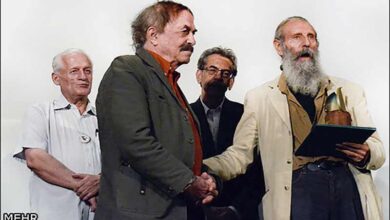A design about Nasser Taghvai

On the occasion of Nasser Taghvaei’s birthday, Behzad Khorshidi has published a design based on the characteristics of this Iranian filmmaker.
In this project, which has been given to ISNA in a special form, Khorshidi has explained about his portrayal of cultural and artistic figures: My approach to graphic design in recent years, especially portraiture of cultural figures and figures, while respecting this Adults, on the other hand, is experimenting with new visual graphic techniques with today’s audience. Graphic art, which is actually a sub-branch of the art of painting, draws its dynamism from the so-called eternity. Digital Art is also one of the most modern forms of the contemporary world.
He further said about Iranian filmmaker Nasser Taghvai: Nasser Taghvai (born July 12, 1941 in Abadan) was a prominent filmmaker of the new wave of Iranian cinema, a storyteller, and like all southerners of Iran, concerns about the climate and culture of Khuzestan are reflected in their narrative. The peak of modern Iranian fiction begins in the 1940s and 1950s, with consequent geopolitical sensitivities, such as Nationalization of the Iranian oil industry, which is also influential in The Neighbors By Ahmad Mahmoud. Taghvai was no exception. But the important thing is that Taghvai chooses the cinema camera to express his words. A filmmaker who began his career making documentaries in the 1960s.
“Khorshidi refers to Taghvai compositions: Bad-e Jenn is the best-known documentary of Nasser Taghvai’s career; A film that deals with Ahl-e-Hawa ceremonies in southern Iran. Of course, the filmmaker has also made two short films among his documentaries: Telephone and Rahaee, produced in 1971. Rahaee was well received by festivals in those years and introduced Taghvai as a talented filmmaker to the film community. Aramesh dar Hozur Deegaran, produced in 1972, is the first and best feature film of Nasser Taghvai; In fact, Taghvai’s first film is much more modern than his other works. In other words, the atmosphere and atmosphere of this film completely followed the structures of modern cinema, modern European cinema of that time, rather than realist storytelling cinema!
Behzad Khorshidi had previously painted a picture of the artist’s face on the occasion of Abbas Kiarostami’s birthday.








